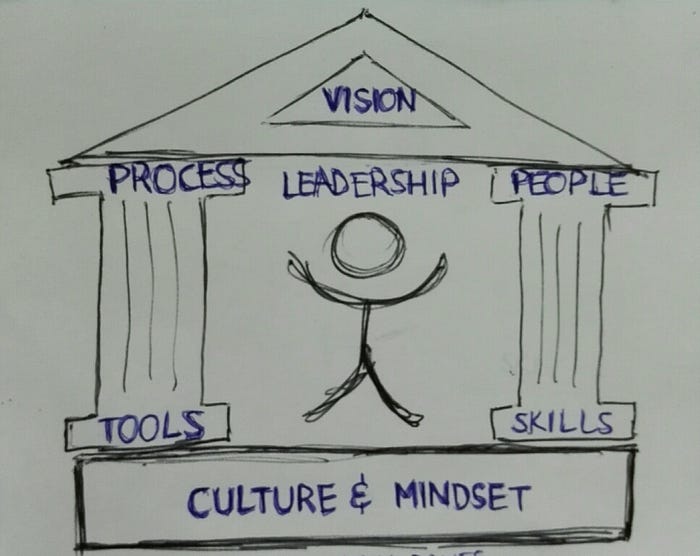
10 Reasons for Agility Success at Spotify
Agile transformations are not easy. Like the elusive pot of gold at the end of the rainbow, becoming agile is an ever-changing goal with no defined road to get there. It requires changing what you do, how you do it, and most importantly, how you think about it, all without a manual or detailed guide. You are provided with merely a one-pager containing four values followed by twelve principles. That’s it.
Perplexingly difficult, yet magnificently simple.
Understandably, this results in a lot of failed agile transformations where organizations have adopted the physical practices such as participating in daily standups or having a Scrum Board but without a mindset change. The result? Making the same mistakes faster, without the data and evidence to analyse and correct the errors later on.
So how do you succeed in an agile transformation?
Look. Launch. Learn.
At the heart of being agile is an immense ability to learn, and to apply this learning to improve how things are being done.
Agile is a journey, not a destination. Which means you need a map and a compass to get you to your destination.
Below is an agile transformation model, adapted from the work of John Shook and the Toyota Lean Manufacturing model, to serve as a map, while your compass will be your organizational measures and the emotions of the stakeholders — both the customers as well as the internal employees. If the results are good, you’re moving in the right direction. If what you do, or how you do it feels good, you’re right on track. If it feels good AND the results are good — bingo! You’ve hit the jackpot!
And then it starts all over again. Been there, done that, got the T-shirt. Now what?

An Agile Transformation Model adapted from the Toyota Production System
For an agile transformation to be successful, it needs a strong foundation based on shared values and an agile mindset. You also need a vision focused on solving a problem and adding value to the users, as depicted by the roof, providing purpose for the existence of the organization. In the centre, and supported on all sides, is the leader, who is the glue that keeps everything aligned.
The two pillars on either side of the leader ensures balance and focuses on “How?” work is done in the organization, rather than “Why?” it is done as governed by the vision. To the left are processes and tools, which are designed to empower and simplify work while ensuring consistent results. On the right are the people and the skills needed to do the work, including both technical and soft skills needed to instill and support the culture and mindset.
Spotify
A case study of a successful agile transformation
One company that succeeded in adopting agile is Spotify, the music, podcast and video streaming service that disrupted the way people discover and use music. So why did they succeed while so many other companies failed?
Looking at the above model as reference for their success, below is ten reasons for their success.
Disclaimer: All the references and facts mentioned are based on my personal and objective research. I’ve never worked or interacted with Spotify thus is open to any corrections.
1. Born out of passion
The first reason for their success, and probably the most important one, can be found by looking at their CEO and the company vision. The CEO, Daniel Ek, himself was a failed musician and have always been passionate about music after receiving a guitar and Commodore 10 computer at the age of 5.
When passion is the driving force behind your work, you’ll do whatever it takes to succeed. Giving up is not an option.
2. A vision that disrupts
Spotify saw a problem that no one even realized they had yet. They realized that the format that music was distributed in restricted the amount of time you could listen to it, where you could listen to it, and who you could listen to in one session.
On a typical CD you can only listen to 60- 90 minutes of music, and only when you have a CD player. Mostly, you can only listen to the same artists, or a variety of artists and songs chosen by someone else and not necessarily to your taste.
Where most people accepted this as a slight irritation to live with, they used this frustration as fuel for innovation. Spotify didn’t accept that this was the way things are done in the music industry, they changed the way it was done.
3. Problem or opportunity?
Most music distributers and musicians saw the impact of the internet on music and the increasing trend of illegal streaming as a problem.
Spotify, on the other hand, embraced these trends and used it to create a solution that addresses these unexpressed needs of the consumers, while at the same time helping the musicians create more great music and market themselves.
Spotify saw an opportunity where others saw a problem.
4. Clarity
The company’s vision is crystal clear, namely to help improve people and musician’s lives by helping more people discover more music, in an accessible and legal way. That means that the company consistently delivers on their brand promise — something that not a lot of companies can say they do.
Their vision is clear, actionable, and specialized. It’s not unrealistic or vague, rather, it is very focused, precise and actionable.
Having a clear, actionable and focused vision has the added benefit of making decisions related to priorities easier. Each time a new product request comes in, questions can be asked to validate whether the request will enhance or distract the user from a delightful user experience. Typically, they could ask questions such as:
“Does this feature make a listener’s life better?”
“Is this feature accessible to everyone, everywhere?”
“Will the feature result in people caring more about the music and the musicians that create the music?”
“Will it help a musician create more great music?”
When the vision is clear and actionable, product development becomes easier.
5. Culture is King
While the vision is the north star telling you “what” to do, the culture and mindset creates an environment that helps teams know “how” to do it. A culture might not be tangible, but it can be clearly defined as Spotify has demonstrated.
Spotify invested effort in creating two short videos to clarify what is most important to them, and to answer “how” things are done at Spotify, in a similar, unrestricted format than the agile manifesto. It provides a framework for decision making rather than a set of rules to follow.
For example, cross-pollination is more important than standardization to Spotify, and community is more important than structure. It doesn’t say that structure is not important, or defines the exact structures to be used, it allows the teams to adapt and use a structure used by other teams when they see value in it.
Spotify’s culture helps clarify how decisions are made within the organization, not how work are, or should, be done.
6. Mindset matters
The mindset of an organization is driven by the leader.
I’ve seen many companies broadcast their values on screensavers, cups, websites and T-shirts for everyone to see, yet when you start interacting with the people that work there, you quickly realize that no-one really follows or believes in it.
The difference with Spotify is that their leader instills and promotes the mindset that he wants the people to follow. A ‘do what I do’ model, rather than the ‘do what I say, not what I do’ model so common in many workplaces.
On the many YouTube video’s where Daniel Ek is interviewed, he demostrates each of the values that is contained in the videos elaborating on the Spotify culture.
With a clear example and consistency in following throught on it, instilling a culture becomes the natural by-product of everyday life.
The people and the customers provide input into the vision and the mindset, but in the end of the day, it is the leader who is the rolemodel responsibile for the success or failure of any culture. When you say autonomy is important, but you micro-manage, the culture will be one of micro-management and not taking responsibility. Regardless of how many places and how many times you repeat and display the value on walls, cups or screensavers.
7. Processes and tools support, rather than drive the organization
The processes and tools at Spotify support the value of change and agility, with everything clearly defined, and nothing final. Like a beehive, there is a structured, or rather balanced, kind of chaos, where the processes are constantly changing.
The processes support the vision and the people, not the other way around. Where so many organizations drive the organization based on the restrictions of the processes and tools, Spotify changed their entire architecture to support the delivery train concept.
8. Collaboration is key
Guilds and squads all work together, sharing knowledge and supporting each other. They help each other where possible, rather than competing against each other.
There is no loser. There are only winning teams, and it is all driven by finding a winning solution to serve the customers.
Each person is respected, and each person respects their peers. There is no one person more important than another, there are only different people that are important at different times, or for different reasons.
9. Happiness matters
The people are the most important part of the equation for success and the entire company is built around motivating and engaging their employees.
When they had a customer satisfaction survey and 91% of people responded that they were happy, with 4% that they were not happy, the feedback from managment was to ask what can they do to make the 4% unhappy employees happier.
Most companies would disregard the unhappy few as outliers and be happy with ‘good enough’ results. Spotify, however, demonstrates the value of respect and trust by addressing the needs of the 4% unhappy employees. They make everyone important (respect), and they trust that people who are unhappy, have a valid reason, and it is worth addressing these needs.
10. Autonomy empowers
Autonomy is one of the success factors for any agile organizations, and Spotify are one of few companies that actually got it right. They don’t tell anyone how to do their job, but whenever someone has a question or need guidance, they are fully supported and helped by those around them.
It means that you need to be confident enough to make decisions on your own. Humble enough to ask for guidance or admit you don’t know the answer. Responsible enough to proactively act even though it’s not in your job description. Curious enough to constantly look for better ways to do things.
Conclusion
To successfully transition towards an agile model, the most important element is having purpose driven by passion and strong leadership to demonstrate the values and mindset of an agile culture.
Originally published in Medium: https://funficient.medium.com/10-reasons-for-agility-success-at-spotify-453516a35201
